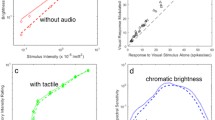Abstract
This article is an exposition of the view that the complexity of biological systems permitsintensive (as opposed toextensive) research on any level. Specifically, (i) new views onstructural information theory used to compare the efficiency of sensory systems in measuring the theoretically derived maximum amount of information in the sensory environment, (ii) the concept of the brain system involving the amygdaloid complex and the hypothalamus as acoupled harmonic oscillator system, and (iii) the concept of the cerebral cortex as ane.m. interferometric (holographic) structure, are outlined.
Similar content being viewed by others
References
R. Granit,Ann. Rev. Physiol. 34, (1972) 1.
A. S. Iberall,Toward a General Science of Viable Systems, (McGraw-Hill, New York, 1972).
V. F. Weisskopf,Physics Today 20, (No. 5, 1967) 23.
P. W. Anderson,Science 177, (1972) 393.
T. W. Barrett,TIT Journal of Life Sciences 1, (1971) 129.
T. W. Barrett,J. Sound & Vibration 20, (1972b) 407.
T. W. Barrett,Acustica 27, (1972c) 90.
T. W. Barrett,Acustica 27, (1972d) 44.
T. W. Barrett,Acustica,29, (1973) 65.
G. W. Stewart,J. Acoust. Soc. Am. 2, (1931) 325.
W. E. Koch,J. Acoust. Soc. Am. 7, (1935) 56.
D. Gabor,J. I. E. E. 93, (1946) 429.
L. Brillouin,Science and Information Theory, 2nd Edition, (Academic Press, New York, 1962).
A. A. Kharkevich,Spectra and Analysis, Consultants Bureau, New York, (1960).
L. Pimonow,Vibrations en R'egime Transitoire — Analyse Physique et Physiologique, (Dunod, Paris, 1962).
T. W. Barrett,J. Acoust. Soc. Am.,54, (1973) 1092.
T. W. Barrett,J. Sound & Vibration 25, (1972) 638.
T. W. Barrett,TIT Journal of Life Sciences 3, (1973) 19.
J. Staage and A. Schief,Cybernetic Problems in Bionics, H. L. Oestreicher and D. R. Moore, eds., (Gordon and Breach, New York, 1966).
W. H. Talbot, I. Darian-Smith, H. H. Kornhuber and V. B. Mountcastle,J. Neurophysiol,31, (1968) 301.
W. Haymaker, E. Anderson and W. H. J. Nauta, eds.,The Hypothalamus, (Thomas, Springfield, Illinois, 1969).
B. E. Eleftherion, ed.,The Neurobiology of the Amygdala, (Plenum, New York, 1972).
T. W. Barrett,Mathematical Biosciences 4, (1969a) 153.
T. W. Barrett,Neuropsychologia 7, (1969b) 1.
T. W. Barrett,Experimental Neurology 34, (1972a) 1.
T. W. Barrett,Mathematical Biosciences 3, (1968) 431.
T. W. Barrett,Mathematical Biosciences 4, (1969c) 311.
T. W. Barrett,Neuropsychologia 7, (1969d) 135.
T. W. Barrett,Mathematical Biosciences 9, (1970) 49.
T. W. Barrett,Brain Research 27, (1971) 271.
T. W. Barrett,Brain Research 28, (1971) 579.
T. W. Barrett,Experimental Neurology 34, (1972) 484.
T. W. Barrett,Beh. Biology 8, (1973) 299.
T. W. Barrett,Beh. Biology 9, (1973) 189.
J. E. Rose, J. F. Brugge, D. J. Anderson and J. E. Hind,J. Neurophysiol.,30, (1967) 769.
R. Galambos, S. Schwartzkopff and A. Rupert,Am. J. Physiol.,197, (1959) 527.
H. T. Chang,J. Neurophysiol.,13, (1950) 235.
H. T. Chang,J. Neurophysiol.,14, (1951) 95.
D. P. Purpura and R. J. Shofer,J. Neurophysiol.,26 (1963) 494.
T. W. Barrett, “International Symposium on Holography in the Biomedical Sciences in Commemorating the 25th Anniversary of the Discovery of Holography”, (New York, 1973).
Author information
Authors and Affiliations
Rights and permissions
About this article
Cite this article
Barrett, T.W. Comparing the efficiency of sensory systems: A biophysical approach. J Biol Phys 1, 175–192 (1973). https://doi.org/10.1007/BF02308893
Issue Date:
DOI: https://doi.org/10.1007/BF02308893




